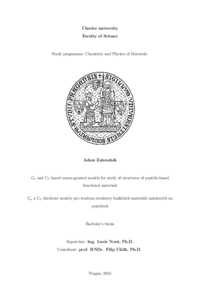Cα a Cβ zhrubené modely pro studium struktury funkčních materiálů založených na peptidech
Cα and Cβ based coarse-grained models for study of structures of peptide-based functional materials
bachelor thesis (DEFENDED)

View/
Permanent link
http://hdl.handle.net/20.500.11956/199794Identifiers
Study Information System: 276763
Collections
- Kvalifikační práce [20861]
Author
Advisor
Consultant
Uhlík, Filip
Referee
Blanco Andrés, Pablo Miguel
Faculty / Institute
Faculty of Science
Discipline
Chemistry and Physics of Materials
Department
Department of Physical and Macromolecular Chemistry
Date of defense
5. 6. 2025
Publisher
Univerzita Karlova, Přírodovědecká fakultaLanguage
Czech
Grade
Excellent
Keywords (Czech)
zhrubený model, struktura molekul, interakční potenciálKeywords (English)
coarse-grained model, molecular structure, interaction potentialPorozumění struktuře proteinů (a celkově struktuře molekul) hraje klíčovou roli při hledání molekul pro specifické aplikace (např. pro pokročilé materiály nebo léčiva a farma- ceutický průmysl). Výpočetní chemie a molekulové simulace mohou hledání správné struktury výrazně usnadnit. Aby bylo možné tyto molekulové simulace provést, je třeba vytvořit silové pole (force field) reprezentující simulovaný systém. V rámci této práce jsou vytvořeny dvě jednoduchá silová pole pro zhrubené modely reprezentující jednotlivé aminokyseliny jejich Cα, resp. Cβ atomem. Množství typů aminokyselin v modelu lze re- dukovat aplikováním aminokyselinové abecedy, v nejjednodušším případě dvoupísmenné. Silové pole pro Cβ atomy bylo testováno pomocí Hamiltoniánského Monte Carla a Pivot Monte Carla. Přesnost skládání jednotlivých struktur byl ověřována jednak numericky (RMSD), jednak vizuálně.
Understanding of protein structure (and molecular structure in general) plays a crucial role in the search for substances with specific applications - advanced materials, medicaments, etc. Computational chemistry and molecular simulations can significantly help with this task. To make molecular simulations possible, a force field representing the simulated system has to be developed. In this work, two simple coarse-grained force fields (for Cα and Cβ atoms) were developed. Additional coarse-graining was applied by implementing an amino acid alphabet, reducing the types of beads in the model from twenty to just two. The force field for Cβ atoms was tested using Hamiltonian Monte Carlo and Pivot Monte Carlo. The precision of the protein folding process has been expressed both numerically (using RMSD) and visually.
